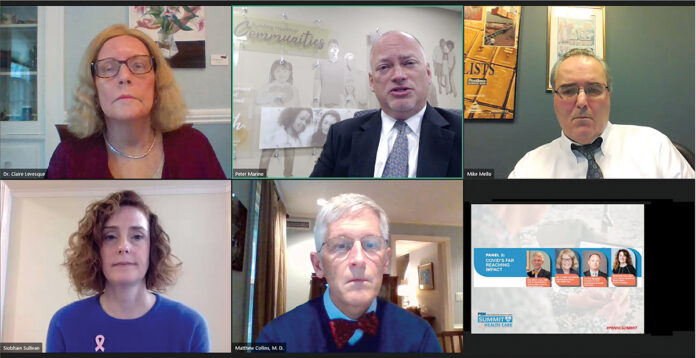Rhode Island businesses yearning to get back to a pre-COVID-19 normal should not get their hopes up yet, particularly in light of a recent surge in cases and new restrictions announced by Gov. Gina M. Raimondo.
Panelists at the PBN virtual Health Care Summit on Oct. 29 acknowledged the persistence of “COVID fatigue” – which could cause people to relax their vigilance against the virus – but they said Rhode Island businesses will still need to be patient.
“A lot of businesses are going to have to reassess their timelines when it comes to bringing people back,” said Peter Marino, CEO of Neighborhood Health Plan of Rhode Island.
Marino compared business response to the pandemic last spring to a light switch – it was either on or off. In the coming months, he said, it should be more like a dimmer switch, capable of subtler responses to changing conditions.
So far, Raimondo has not changed her order restricting office occupancy to 66% of capacity, although she has also urged people who are capable of working at home to do so.
“We need to stay vigilant,” said Dr. Matt Collins, chief medical officer at Blue Cross & Blue Shield of Rhode Island. “The name of the game is still to avoid the virus. … It’s a very sneaky disease.”
Collins said that when the pandemic arrived in March, businesses had to quickly look at their continuity plans, which were usually geared for blizzards, power failures or tech issues – not a long-term pandemic.
“What it came down to was to ensure that business objectives are still being met,” he said.
‘A lot of businesses are going to have to reassess their timelines.’
PETER MARINO, Neighborhood Health Plan of Rhode Island CEO
The PBN Health Care Summit was divided into two separate panels. Collins and Marino were members of the second panel. The other participants were Dr. Claire Levesque, chief medical officer for commercial products at Tufts Health Plan, and Siobhain Sullivan, chief operating officer for clinical operations for Rhode Island Medical Imaging Inc.
In the early days of the pandemic, Sullivan said, Rhode Island Medical Imaging had its patients wait in their cars so they wouldn’t crowd into a waiting room, possibly spreading the potential fatal COVID-19. Cleaning protocols became more stringent. Everyone had to wear a mask.
“We were educating both patients and providers,” she said. “It was very difficult at first. Now, it’s second nature.”
Sullivan said many patients were afraid to leave their homes and come in, which meant some were skipping important tests and procedures. “We are encouraging patients to keep coming in,” she said.
Marino said every business needs to figure out how to operate in a dramatically altered landscape.
Neighborhood Health Plan, for example, has 550 employees. Nearly half of those employees have school-age children who have been learning remotely from home. The company had to plan the best way to get its work done while accommodating employees’ child care needs.
Collins said companies need to be flexible about work hours, and tolerant of different ways people get their work done.
At some point, the threat of the pandemic should begin to recede. But even then, panelists said, things will be different, the so-called “new normal.”
“A lot of companies are going to have to rethink how they operate,” Marino said. Companies have become accustomed to having a large part of the workforce working from home, and communicating through digital platforms such as Zoom. Much of that will continue.
“I yearn for the personal contact, myself,” Marino said. “Many folks will look to return to that when it’s safe. But what will be the impact on folks interacting with each other, the impact on our [business] culture? There will have to be an enormous effort to maintain the great cultures we have created here.”
Sullivan said having employees work from home has advantages: There’s no commuting; companies can draw employees from a wider geographic area; and there are cost savings. But she also said she misses the “water cooler” effect of close interaction with fellow workers.
Panelists also expressed concern about the mental health impact of the pandemic, particularly when combined with a divisive election cycle and civil unrest in the country.
Levesque, of Tufts Health Plan, said anxiety and depression are on the rise. People who are working at home are stressed because they’re juggling family obligations and work responsibilities all in one place, blurring the work-life balance. Also, people who must go to work are afraid of increased exposure to COVID.
And then there are the thousands of workers who have lost their jobs.
Levesque said Tufts Health Plan is seeing a lot of claims for injuries related to falls, which is considered an early indicator of opioid and alcohol abuse.
She said it’s important to reduce the stigma surrounding behavioral health issues. Employees should be encouraged to take vacation days, even if they can’t travel. Or even take sick days for mental health reasons.
Tufts has an Employee Assistance Fund, she said, that allows employees to apply for $1,000 to use any way they want.
Levesque said employers need to communicate information about mental health resources to their employees – and preferably not by tucking it into a human resources handbook. “No one reads those,” she said.
“It’s all about engagement and trust,” Marino said. “Don’t ask ‘How are you doing?’ but ‘How are you holding up?’ Or just ask folks what’s on their minds, instead of sticking to very specific questions about work.”
In response to a question about the future of the Affordable Care Act, better known as Obamacare, the panelists said they are concerned, particularly in light of an upcoming Supreme Court case. In November, the high court is expected to hear oral arguments in a case seeking to overturn the health care law.
Millions of Americans could lose their health insurance if the law is struck down.
“I remember treating patients before the Affordable Care Act; there was a huge change that came about as a result of the act,” said Collins. “We created access to health insurance. It would be unconscionable to say, ‘Let’s just get rid of Obamacare.’ ”
Marino said there are health care providers in the state who count on the federal money generated by Obamacare. He also said that the end of Obamacare funding could send the state budget into disarray.
“There’s a lot at stake here,” he said. “We need to keep moving down the path of what I’d call strong health care for all.”













